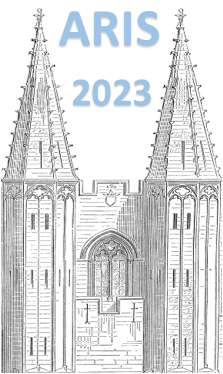Orateur
Description
We report on studies of `$^{14}$B and $^{10}$Li using the (t,p) reaction in inverse kinematics with HELIOS at Argonne National Laboratory. Two-neutron transfer provides information complementary to that obtained with one-neutron transfer. The selective nature of (t,p) is ideal for studying neutron pairing, configuration mixing and shape-coexistence, effects necessary to understand regions where the shell-model orbitals are changing rapidly with N/Z. Here, we have studied the $^{12}B$(t,p)$^{14}$B and $^8$Li(t,p)$^{10}$Li reactions. In $^{14}$B, data for $^{14}$Be beta-decay [1] and the $^{14}$Be(p,n)$^{14}$B reaction [2] suggest a 1$^+$ excitation at E$_X$($^{14}$B)=1.27 MeV interpreted as a low-lying intruder state with strong $\nu$(1s$_{1/2})^2$ character. The properties of this and other $\nu$(sd)$^2$ states in $^{14}$B that can be populated in (t,p) provide information about the changing nature of the p-sd splitting in this mass region that is important, for example, in understanding the disappearance of the N=8 shell gap suggested in $^{12}$Be. In $^{10}$Li, the nature of the low-lying structure remains controversial with conflicting interpretations of data from the $^9$Li(d,p)$^{10}$Li reaction[3,4] suggesting the dominance of either s-wave or p-wave excitations. The selectivity of (t,p) can shed more light on this behavior, but also identify two-neutron (sd)$^2$ excitations that, due to their small overlap with $^9$Li$_{g.s.}$+n, may be narrow despite $^{10}$Li being unbound. The properties of such states in $^{10}$Li can provide information that is important for a detailed understanding of the two-neutron halo structure of $^{11}$Li.
Secondary $^{12}$B and $^8$Li beams produced using the RAISOR separator at the ATLAS facility at Argonne National Laboratory bombarded a $^3$H target consisting of $^3$H adsorbed into a 450 $\mu$g/cm$^2$ Ti foil. Protons transported by the HELIOS uniform magnetic field were detected using an array of position-sensitive silicon detectors, and recoiling beam-like reaction products were detected at forward angles using a set of E-E silicon-detector telescopes. We will present the results of first measurements of the $^{12}$B(t,p)$^{14}$B and $^8$Li(t,p)$^{10}$Li reactions, and compare the observations with predictions of shell-model calculations for two-neutron transfer leading to states in $^{14}$B and $^{10}$Li.
This research was supported by the US Department of Energy, Office of Nuclear Physics, under Grants No. DESC0014552, (UConn), No. DE-FG02-96ER40978 (LSU), and No. DE-AC02-06CH11357 (ANL).
[1] N. Aoi et al., Phys. Rev. C 66, 014301 (2002).
[2] Y. Satou et al., Phys. Lett. B 697, 459 (2011).
[3] H. B. Jeppesen et al., Phys. Lett. B 642, 449 (2006).
[4] M. Callavaro et al., Phys. Rev. Lett. 118, 012701 (2017).

